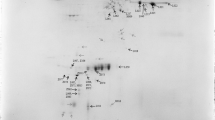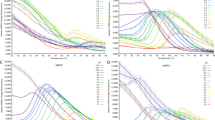Summary
The soluble proteins of the haemolymph, ovary and eggs of the honey bee were separated by electrophoresis on cellulose acetate foils and on polyacrylamide gels. The predominant haemolymph fraction (60–80%) is a female-specific protein. Corresponding fractions are found in the ovary and in uncleaved eggs. According to the results, it is highly probable that these fractions represent the yolk material or vitellogenin. InApis, this vitellogenin is represented by only one protein band which carries no carbohydrate components.
The haemolymph titre of vitellogenic protein depends on the physiological state of the female bees. In the worker bees, haemolymph yolk proteins are detectable only during the nurse age, whereas in queens they can be found throughout the year. It may be noted that in the mated and egg producing queens the concentration of vitellogenin in the haemolymph is lower than in virgin queens and in adult non-laying queens.
The rate ofin vivo protein synthesis was determined by injecting a mixture of14C-amino acids and measuring the radioactivity in pherogram bands using a methane flow counter. In the actively laying queen the rate of vitellogenin synthesis is 3 times higher than that of the non-sex-specific blood proteins. Approximately 85% of the labeled proteins which are released from the fat body are yolk material. In contrast to other insects, non-laying queens were also found to synthesize vitellogenin; however, the rate did not exceed that of the other serum proteins. The fate of yolk material in such females is unknown. In the ovary, synthesis of the euplasmic proteins occurs at a rate similar to that of the nonspecific haemolyph fractions. The appearance of radioactivity in the ovarian yolk is delayed compared with all other proteins. This indicates that these proteins are labeled byde novo synthesis, whereas the yolk is not built up within the ovary. This conclusion is further supported by the fact that the increase in specific radioactivity of ovarian yolk proteins occurs at a time when free14C-amino acids are no longer available in the haemolymph. Following the maximum intensity of labelling of yolk proteins the specific activity declines. From the data it can be estimated that the period of vitellogenesis for a single follicle is 2 days; 2 additional days of maturation, during which glycogen synthesis and chorion formation occur, are required before oviposition.
Zusammenfassung
Die löslichen Hämolymph-, Ovarund Eiproteine der Honigbiene wurden elektrophoretisch auf Celluloseacetat-Streif en und Polyacrylamid-Gelen aufgetrennt. Die dominierende Hämolymph-Fraktion (60–80%) ist ein Weibchen-spezifisches Protein. Korrespondierende Fraktionen sind im Ovar und in ungefurchten Eiern zu finden. Aufgrund verschiedener Ergebnisse wird es als sehr wahrscheinlich angesehen, daß diese Fraktionen das Dotter-Material (= Vitellogenin) repr⇒entieren. Bei Apis besteht das Vitellogenin nur auseiner Protein-Bande ohne Kohlenhydrat-Komponenten.
Der Titer des Dotter-Proteins in der Hämolymphe hängt vom physiologischen Zustand der weiblichen Bienen ah. Bei der Arbeiterin ist nur während der Ammen-Tätigkeit Vitellogenin in der Hämolymphe zu finden, bei der Königin dagegen permanent und zu allen Jahreszeiten. Bemerkenswerterweise ist bei begatteten und eierlegenden Königinnen die Konzentration des Dotter-Materials in der Hämolymphe niedriger als bei unbegatteten und adulten, nicht-eierlegenden.
Die Proteinsynthese-Raten wurdenin vivo nach Injektion eines14C-Aminosäuren-Gemisches bestimmt. Zur Messung der Radioaktivität der einzelnen Pherogramm-Banden wurde ein Methan-Durchflußzähler verwendet. Bei intensiver Legetätigkeit einer Königin liegt die Rate der Vitellogenin-Synthese dreimal höher als die der nicht-weibehen-spezifischen Blutproteine. Ungefähr 85% der vom Fettkörper abgegebenen Proteine sind Dotter-Material. Im Gegensatz zu anderen Insekten synthetisieren auch nicht-eierlegende Königinnen Vitellogenin; in diesem Falle liegt die Syntheserate jedoch nicht höher als die der übrigen Serum-Proteine. Der Verbleib des Dotter-Materials bei solchen Königinnen ist unbekannt. Im Ovar verläuft die Synthese der Euplasma-Proteine ungefähr mit der gleichen Rate wie die der nicht-weibchen-spezifischen Hämolymph-Fraktionen. Im Vergleich mit allen anderen Proteinen tritt die Markierung des Ovar-Dotters verspätet auf. Daraus kann geschlossen werden, daß das Dotter-Material nicht innerhalb des Ovars synthetisiert wird. Dieser Schluß wird außerdem durch den Befund gestützt, daß der Anstieg der spezifischen Aktivität der Dotter-Proteine im Ovar erst zu einem Zeitpunkt erfolgt, in dem in der Hämolymphe keine freien14C-Aminosäuren mehr verfügbar sind. Auf das Markierungs-Maximum der Dotter-Proteine folgt ein relativ rascher Abfall der spezifischen Aktivität. Aus den Werten kann die Vitellogenese-Dauer eines einzelnen Follikels mit 2 Tagen bestimmt werden. Bis zur Eiablage werden anschließend noch 2 weitere Tage benötigt, in denen die Glykogen-Synthese und Chorion-Bildung ablaufen.
Similar content being viewed by others
Literatur
Bell, W. J.: Demonstration and characterization of two vitellogenic blood proteins inPeriplaneta americana: An immunochemical analysis. J. Insect Physiol.16, 291–299 (1970).
Bell, W. J.: Starvation-induced oöcyte resorption and yolk protein salvage inPeriplaneta americana. J. Insect Physiol.17, 1099–1111 (1971).
Bier, K.: Über Phasen gesteigerter Protein- und Kohlehydrateinlagerung und die Fettverteilung im Hymenopterenovar. Zool. Anz., Suppl.18, 422–429 (1955).
Bier, K.: Autoradiographische Untersuchungen zur Dotterbildung. Naturwissenschaften49, 332–333 (1962).
Bier, K.: Autoradiographische Untersuchungen über die Leistungen des Follikelepithels und der Nährzellen bei der Dotterbildung und Eiweißsynthese im Fliegenovar. Wilhelm Roux' Arch. Entwickl.-Mech. Org.154, 552–575 (1963).
Bier, K.: Oogenese, das Wachstum von Riesenzellen. Naturwissenschaften54, 189–195 (1967).
Bier, K.: Oogenesetypen bei Insekten und Vertebraten, ihre Bedeutung für die Embryogenese und Phylogenese. Zool. Anz., Suppl.33, 7–29 (1970).
Bier, K., Ramamurty, P. S.: Elektronenoptische Untersuchungen zur Einlagerung der Dotterproteine in die Oocyte. Naturwissenschaften51, 223–224 (1964).
Bodnaryk, R. P., Morrison, P. E.: Immunochemical analysis of the origin of a sexspecific accumulated blood protein in female houseflies. J. Insect Physiol.14, 1141–1146 (1968).
Bonhag, P. F.: Ovarian structure and vitellogenesis in insects. Ann. Rev. Ent.3, 137–160 (1958).
Brookes, V. J.: The induction of yolk protein synthesis in the fat body of an insect,Leucophaea maderae, by an analog of the juvenile hormone. Develop. Biol.20, 459–471 (1989).
Büdel, A.: Bienenphysik. In: A. Büdel und E. Herold, Biene und Bienenzucht, S. 244–270. München: Ehrenwirth 1960.
Davis, B. J.: Disc electrophoresis. II. Method and application to human serum proteins. Ann. N. Y. Acad. Sci.121, 404–427 (1964).
Dejmal, R. K., Brookes, V. J.: Solubility and electrophoretic properties of ovarial protein of the cockroach,Leucophaea maderae. J. Insect Physiol.14, 371–381 (1968).
Engelmann, F.: Endocrine activation of protein metabolism during egg maturation in an insect. Amer. Zool.5, 673 (1965).
Engelmann, F.: Female specific protein: Biosynthesis controlled byCorpus allatum inLeucophaea maderae. Science165, 407–409 (1969).
Engelmann, F.: The physiology of insect reproduction. Oxford: Pergamon 1970.
Engelmann, F.: Juvenile hormone-controlled synthesis of female-specific protein in the cockroachLeucophaea maderae. Arch. Biochem.145, 439–447 (1971).
Engelmann, F., Hill, L., Wilkens, J. L.: Juvenile hormone control of female specific protein synthesis inLeucophaea maderae, Schistocerca vaga, andSarcophaga bullata. J. Insect Physiol.17, 2179–2191 (1971).
Engels, W.: Der zeitliche Ablauf von Protein- und Kohlenhydratsynthesen in der Oogenese beiApis mellifica. Zool. Anz., Suppl.29, 243–251 (1966).
Engels, W.: Herkunft der Dotter-Proteine beiApis mellifica. Proc. 23. Int. ApimondiaCongr. Moscow (1971).
Engels, W., Drescher, W.: Einbau von3H-D-Glucose während der Oogenese beiApis mellifica. Experientia (Basel)20, 445–447 (1964).
Feir, D., Krzywda, L.: Concentration of insect hemolymph proteins under various experimental conditions. Comp. Biochem. Physiol.31, 197–204 (1969).
Herrmann, H.: Die neurohormonale Kontrolle der Paarungsflüge und der Eilegetätigkeit der Bienenkönigin. Z. Bienenforsch.9, 509–544 (1969).
Highnam, K. C., Hill, L.: The comparative endocrinology of the invertebrates. London: Arnold 1969.
Highnam, K. C., Lusis, O., Hill, L.: The rôle of thecorpora allata during oöcyte growth in the desert locust,Schistocerca gregaria Forsk. J. Insect Physiol.9, 587–596 (1963).
Hill, L.: The incorporation of C14-glycine into the proteins of the fat body of the desert locust during ovarian development. J. Insect Physiol.11, 1605–1615 (1965).
Kessel, R. G., Beams, H. W.: Micropinocytosis and yolk formation in oocytes of the small milkweed bug. Expt. Cell Res.30, 440–443 (1963).
Kunz, W., Petzelt, C.: Synthese und Einlagerung der Dotterproteine beiGryllus domesticus. J. Insect Physiol.16, 941–947 (1970).
Krause, G., Sander, K.: Ooplasmic reactions systems in insect embryogenesis. Advanc. Morphogenes.2, 259–303 (1962).
Lensky, Y., Alumot, E.: Proteins in the spermatheca and haemolymph of the queen bee (Apis mellifica L. var.lingustica Spin.). Comp. Biochem. Physiol.30, 569–575 (1969).
Lüscher, M., Bühlmann, G., Wyss-Huber, M.: Juvenile hormone and protein synthesis in adult female cockroaches. Mitt. Schweiz. Entom. Ges.44, 197–206 (1971).
Mackensen, O.: Effect of carbon dioxide on initial oviposition of artificially inseminated and virgin queen bees. J. econ. Entom.40, 344–349 (1947).
Maul, V.: Dynamik und Erbverhalten plasmatischer Eibereiche der Honigbiene. Zool. Jb. Abt. Anat. u. Ontog.84, 63–166 (1967).
Morohoshi, S., Shimada, J.: The control of growth and development inBombyx mori. VIII. Effect of the Corpus allatum, suboesoephageal ganglion and brain on the incorporation of14C-Leucine into fat body, haemolymph and ovarian proteins. Proc. Jap. Acad.47, 319–324 (1971).
Müller, J.: Über die Entwicklung der Eier im Eierstock bei den Gespenstheuschrecken und eine neuentdeckte Verbindung des Rückengefäßes mit den Eierstöcken bei den Insekten. Berlin 1825.
Nath, V.; Animal gametes (female). London: Asia Publ. House 1968.
Nielsen, D. J., Mills, R. R.: Changes in electrophoretic properties of haemolymph and terminal oöcyte proteins during vitellogenesis in the american cockroach. J. Insect Physiol.14, 163–170 (1968).
Nünemann, H., Moser, J. G.: Isolierung und immunelektrophoretische Charakterisierung von Proteinen aus Teilen einzelner Eier der Hausgrille,Acheta domesticus. Zool. Anz., Suppl.33, 113–120 (1970).
Ornstein, L.: Disc electrophoresis. I. Background and theory. Ann. N. Y. Acad. Sci.121, 321–349 (1964).
Pan, M. L.: The synthesis of vitellogenin in theCecropia silkworm. J. Insect Physiol.17, 677–689 (1971).
Pan, M. L., Bell, W. J., Telfer, W. H.: Vitellogenic blood protein synthesis by insect fat body. Science165, 393–394 (1969).
Petzelt, C., Bier, K.: Hemmung und Induktion von Proteinsynthesen durch Actinomycin in den wachsenden Oocyten vonMusca domestica. Wilhelm Roux' Archiv164, 341–358 (1970a).
Petzelt, C., Bier, K.: Synthese der Hämolymphproteine und die Aufnahme der Dotterfraktion in die Oocyte unter Actinomycin-Einfluß (Untersuchungen anMusca domestica). Wilhelm Roux' Archiv164, 359–366 (1970b).
Raven, C. P.: Oögenesis, the storage of developmental information. London: Pergamon Press 1961.
Scheurer, R., Lüscher, M.: Nachweis der Synthese eines Dotterproteins unter dem Einfluß derCorpora allata beiLeucophaea maderae. Rev. suisse Zool.75, 715–722 (1968).
Shigematsu, H.: Synthesis of blood proteins by the fat body in the silkworm,Bombyx mori L. Nature (Lond.)182, 880–882 (1958).
Shigematsu, H.: Protein metabolism in the fat body of the silkworm,Bombyx mori L. Bull. sericult. Exp. Stat. Jap.16, 141–170 (1960).
Srivastava, M. D. L.: Cytoplasmic inclusions in oogenesis. Int. Rec. Cytol.18, 73–98 (1965).
Telfer, W. H.: Immunological studies of insect metamorphosis. II. The role of sex-limited blood protein in egg formation by theCecropia silkworm. J. gen. Physiol.37, 539–558 (1954).
Telfer, W. H.: The selective accumulation of blood proteins by the oocytes of saturniid moths. Biol. Bull.118, 338–351 (1960).
Telfer, W. H.: The route of entry and localization of blood proteins in the ooeyte of saturniid moths. J. biophys. biochem. Cytol.9, 747–759 (1961).
Telfer, W. H.: The mechanism and control of yolk formation. Ann. Rev. Entom.10, 161–184 (1965).
Telfer, W. H., Rutberg, L. D.: The effects of blood depletion on the growth of the oocytes in theCecropia moth. Biol. Bull.118, 352–366 (1960).
Wigglesworth, V. B.: The fate of haemoglobin inRhodnius prolixus (Hemiptera) and other blood-sucking arthropods. Proc. roy. Soc. B131, 313–339 (1943).
Wyss-Huber, M., Lüscher, M.: Influence of juvenile hormone on ovarian protein synthesis inLeucophaea maderae. Gen. comp. Endocr.13, 542 (1969).
Author information
Authors and Affiliations
Additional information
Herrn H. Fahrenhorst danke ich für Hilfe bei den Bienen-Arbeiten, Frl. B. Höltken und Frl. A. Rath für sorgfältige technische Assistenz, Frl. M. Krink für Zeichenhilfe bei den Abbildungen. Ein Teil der Untersuchungen wurde durch eine Herrn Prof. Dr. K. Bier† gewährte Sachmittel-Zuwendung des Landesamtes für Forschung in Nordrhein-Westfalen gefördert
Rights and permissions
About this article
Cite this article
Engels, W. Quantitative Untersuchungen zum Dotterprotein-Haushalt der Honigbiene (Apis mellifica). W. Roux' Archiv f. Entwicklungsmechanik 171, 55–86 (1972). https://doi.org/10.1007/BF00584414
Received:
Issue Date:
DOI: https://doi.org/10.1007/BF00584414




